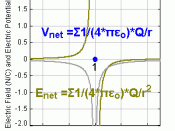Sian Zhang
Electromagnetism constitutes one of the four fundamental interactions in nature. This is the reason why electromagnetism finds many practical applications which are intertwined with modern life. Yet despite its significance, understandings of these forces are only a relatively recent development. For millennia, the sciences of electricity and magnetism were incorrectly conceived as distinct phenomena, and it was only in the 19th century that they were unified as electromagnetism.
Electromagnetism's conception began in 1820, with Hans Christian Orsted, a Danish physicist who noticed that a compass is deflected from its natural orientation when placed near an electric current in a wire. With further experimentation, Orsted demonstrated that an electric current in a wire produces a circular magnetic field, confirming the intimate relationship between electricity and magnetism.
Oersted's findings sparked the interest of the scientific community. Within a year, Andre- Marie Ampere, discovered and quantified new scientific theories. Specifically, Ampere investigated the mechanical forces between current-carrying conductors and their magnetic fields.
It is appropriate then, that Ampere named this new branch of science 'electrodynamics', given that he observed movement due to electrical and magnetic phenomena. By observing the interaction of current-carrying wires, most notably those of parallel conductors, Ampere saw that conductors attracted or repelled each other based on the direction of their currents. From his experimentation, Ampere formulated what is now known as Ampere's Law, which describes the magnetic field created by a current carrying conductor.
B=KI/L or B=KQ/ls
This is the simplified form of the formula, in which I, the current running through the conductor (measured now in Amperes), is directly proportional to the B, magnetic field strength measured in Teslas. It is also important to note that current is by definition, the flow of electrical charge, and is thus, also equal to Coulombs per second or...


